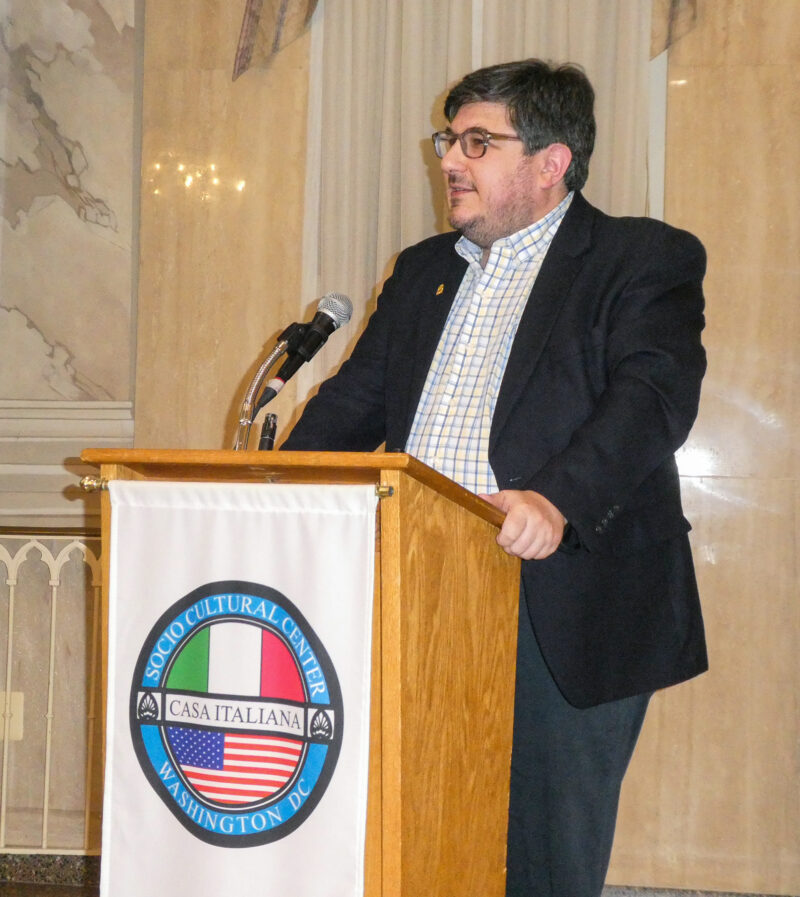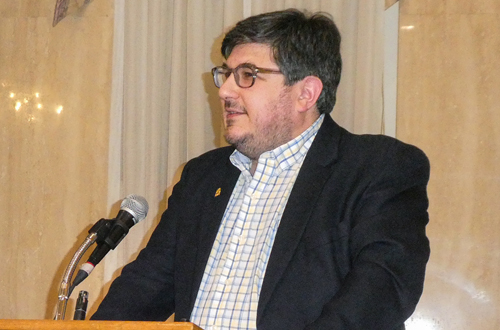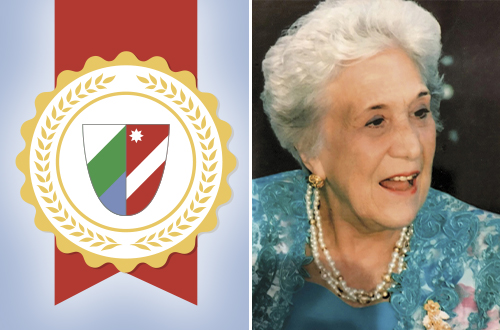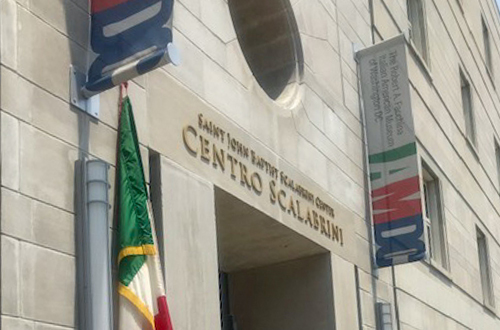-
History of Italian Stamps
Topic of Talk by Smithsonian Expert Dan Piazza
By Nancy DeSanti, 1st Vice President-Programs
AMHS members and guests were treated to a fascinating and informative talk on Italian stamps. The talk was a lesson in history as well. Daniel A. Piazza, the Smithsonian’s leading stamp expert, was the speaker at a luncheon program at Casa Italiana on Sunday afternoon, June 25, 2023.

Dan Piazza of the National Postal Museum addresses the AMHS June 25 general meeting at Casa Italiana.
Credit: Sam YothersDan has been the Chief Curator of the Smithsonian’s National Postal Museum since 2014. He is responsible for exhibitions, acquisitions, and research related to the museum’s collection of six million postage stamps and postal artifacts comprising one of the largest such collections in the world. Visitors may be surprised to learn that, despite its name, about half of the material in the museum came from other nations. The museum, located a few blocks from Casa Italiana, opened to the public in 1993.
As Chief Curator, Dan has overseen exhibitions that included “Freedom Just Around the Corner: Black America from Civil War to Civil Rights,” which won the 2016 Smithsonian Research Prize. A few of his other exhibitions were on Alexander Hamilton, on 100 years of the national parks in 2016, and on the world’s most famous stamp. In case you are wondering what it is, it is a unique one-cent magenta-colored by British Guiana in 1856.
Dan earned his master’s degree in American History from Syracuse University where he also taught history courses and was a Fellow in the university library’s rare book collection. He lectures widely and contributes to many philatelic journals and collector periodicals. He is also a member of several national and international philatelic societies, including the prestigious Royal Philatelic Society of London. In fact, when Dan finished his talk, he was heading to the airport to go to London to give a talk to that organization.
Dan said he has been interested in stamps since he was a boy, especially Italian stamps — not surprising since his father’s side of the family is from Agrigento, Sicily, and his mother’s side of the family has roots in Catanzaro in the region of Calabria, the city of Genoa, and Friuli province.
In a wide-ranging presentation, Dan traced the origins of the Italian postal service in northern Italy in the 13th century. Later, a primitive version of a stamp appeared in Venice in 1608.
He noted that the development of a postal system occurred earlier in Italy than in the rest of Europe. He traced the history of stamps through the Napoleonic era, when Italian towns were given French names and the French calendar was used. However, the Congress of Vienna restored national borders after Napoleon’s fall in 1815. By 1819, postal paper could be purchased for later use. Thus, such paper was effectively a government I.O.U. for letters to be carried.
Dan explained that, before the unification of Italy, there were treaties to account for different currencies and borders. Such accounting was a big headache and required post offices to have large accounting departments to sort everything out.
At that time, there was no home delivery, so everyone had to go to the post office to get the mail. The names of addressees who had mail waiting at the post office were published in the local newspaper. Dan pointed out that before 1847 this procedure was also the practice here in the United States. In fact, American Express and Wells Fargo got their starts as mail forwarders.
In the 16th and 17th century, because of widespread banditry, some envelopes had a warning in the form of a drawing of a hangman’s noose since most people were illiterate in those days, including the mail carriers. Today, the consequences of tampering with the mail are not as severe, but Dan advised against sending abroad greeting cards with colored envelopes since they are seen as likely containing cash. Registered mail is also a target because it is viewed as containing valuables.
Speaking about the stamps themselves, he noted that the best stamp artists have a knack for combining pictures and text in a very small space, and their services are very much in demand. In 1950, one of Italy’s best-known stamp artists, Corrado Mezzana, made a set of stamps called Italia al Lavoro (Italy at Work) featuring traditional crafts of all 20 regions of Italy. For example, he showed Mezzana’s stamp featuring embroidery and lacemaking for the region of Abruzzo and Molise, which was combined at that time until 1963.
As to the Italian postal system nowadays, Dan noted that, like many postal systems in Europe, it was privatized in 1998. The results have been mixed, so the jury is still out on its effectiveness.
He told the audience that the National Postal Museum has a permanent stamp gallery which he curated and which includes information about Italian stamps, adding that the material is constantly being digitized.
Dan, an AMHS member himself, has offered to give Society members and friends a guided tour of the museum in September. Members will be notified when a date has been scheduled. Visitors will be able to see some of the items Dan mentioned in his talk, such as the oldest stamped envelope in the museum’s collection. It is a piece of mail sent in 1390 from Damascus to Venice. It took about a month to be delivered. An example of the hangman’s noose envelope is in the museum’s collection. There is also a 1920s photograph of Charles Ponzi wearing a trench coat and fedora. If visitors wonder why this namesake of the Ponzi pyramid scheme is represented in the museum, Dan explained during his talk that Ponzi earned his place in a postal museum because he used the international postal system for his scam involving exchange rate differences and international reply coupons.
AMHS members may recall that Dan gave us an excellent virtual talk in July 2022 on the history of the stamps of fascist Italy and then in October 2022, he gave AMHS members a guided tour of the baseball exhibit which he curated in the postal museum.
The June 25 program was organized by the AMHS and was co-sponsored by the Casa Italiana Sociocultural Center. The delicious cold lunch was catered by A. Litteri. Many thanks to those members who helped deliver, set up, and serve the lunch, donated raffle prizes, and bought raffle tickets. A special thanks is owed to Sonny Scafetta for suggesting Dan as our guest speaker.
July/August 2023
-
A Message from the President

Dear members and friends:
Happy summer!
You have no doubt seen or experienced how Italians come alive in the summertime. They can finally hang up their puffy coats, savor the fruits of their garden labor, take more regular strolls in the local piazza, and enjoy sagre, music concerts, and trips to the beach. And, of course, summertime is also vacation time for most Italians. We here have much to look forward to as well, including our upcoming programs, which present a nice selection of social events of sufficient variety to appeal to most of our members.
These upcoming events will be a continuation of a busy and entertaining spring. On May 6, a group of our members took advantage of an outing to the Italian-American Museum of Washington, D.C. (IAMDC). The group learned a lot about the influence and impact of Italian Americans in the area and then enjoyed a lunch at Ella’s Wood-Fired Grill. There are more details about the event in “Siamo Una Famiglia.” On May 20, we held a virtual event featuring Italian-American podcaster Stephanie Longo. Ms. Longo outlined the tools that we need to begin preserving our local Italian-American history. See our piece inside for more description. On June 4, we held a virtual event with John Michael Howard, who talked about the book “Living to be 100”, in which there was a discussion of the lifestyle characteristics of the oldest and healthiest people in the world, including the residents of Sardinia. Find out more about his talk in the adjoining article. On June 20, AMHS members and friends celebrated Italian Heritage Day at Nationals Park while watching the Nats take on the St. Louis Cardinals. Then, on June 25, the Society held its second general meeting of the year at Casa Italiana. Dan Piazza, the Chief Curator at the Smithsonian’s National Postal Museum, delivered an overview of Italian stamps and the Italian postal system. You can find out more about it in the adjoining article.
Regarding our exciting upcoming events, mark your calendar for Sunday, July 9th, and join the AMHS for a self-guided tour of the exhibition “Going through Hell: The Divine Dante” at the National Gallery of Art. The tour will get under way at 11:00 am. Following it, participants can enjoy lunch at the Cascades Café. On July 30, we will hold a virtual event at 7:30 pm. with Michael Markowitz, who will discuss Roman coinage. His mother was Italian. Check out our website for more information. Our annual Ferragosto picnic will take place on Sunday, August 13, at Fort Ward Park in Alexandria. This event has become one of our most popular, so be sure to set the date aside.
The AMHS Scholarship Committee has completed its evaluation of this year’s applicants. We are pleased to announce that Sofia DeLuca is the winner of our AMHS scholarship. Ms. DeLuca is a rising senior at George Washington University, where she is majoring in Political Science with a minor in Italian Language and Literature as well as Peace Studies. She is from New York and traces her family roots to the regions of Campania and Veneto. Her academic performance has been outstanding, and she places a great value on her Italian heritage, making her a most deserving winner. We are also pleased to announce the winners of the first Angela Lastrico Raish music scholarships. They are Giorgio Consolati (flutist) of the Johns Hopkins University’s Peabody Institute, Lauren Barchi (vocalist) of Rutgers University, Sonia Fortezza (vocalist) of Montclair State University, Amanda Murro (saxophonist/music education) of Montclair State University, and Javera Chaudhry (vocalist) of Rutgers University. The winners, who all have Italian backgrounds, are exceptional talents and are most deserving of their awards. For additional information on all the winners, see the article by Liz DiGregorio.
At the end of this year, all five of the AMHS officers as well as three members of our Board of Directors will be stepping down, as their terms of office end. The five officers and nine members of the Board of Directors form the Executive Committee (EC). We need volunteers for a Nominating Committee, whose urgent task will be to find candidates to succeed our outgoing officers and Board members. If you would like to be a part of such a committee, please contact any of the officers or any EC member to let us know of your interest. Of course, while thinking about the Nominating Committee, you could also consider serving a two-year term as an officer or a three-year term as a member of the Board of Directors. The five officer positions are President, Vice President/Programs, Vice President/Membership, Treasurer, and Secretary. This is an exciting time to be in the leadership of the Society, and our organization, like all organizations, depends on new ideas and fresh approaches in order to prosper in changing times. If the idea of helping to steer the AMHS into the years ahead appeals to you, please let any officer or EC member know.
Do not forget about our online shop if you are looking for summer gift ideas!
Thank you for reading and have a safe and enjoyable summer!
Best regards,
Ray LaVerghetta
July/August 2023
-
Acting Legend Robert De Niro Has Molise Roots
By Joseph “Sonny” Scafetta, Jr.

Robert De Niro in his 1981 Oscar-winning role as boxer Jake LaMotta in Raging Bull.
Credit: Getty ImagesRobert Anthony De Niro, Jr. was born on August 17, 1943, in the Manhattan borough of New York City, the only child of painters Robert Anthony De Niro and his wife Virginia Admiral. His great-grandparents, Giovanni Di Niro (note spelling) and Angelina Mercurio, had emigrated in 1887 from the town of Ferrazzano (population 3,317 in the 2017 Census) in the province of Campobasso in the region of Molise. De Niro’s parents separated when he was two years old and he was raised by his mother in the Greenwich Village and Little Italy sections of Manhattan. He dropped out of high school when he turned 16 to pursue an acting career. He studied acting at the HB Studio, Lee Strasberg’s Actors Studio, and the Stella Adler Conservatory, all in New York.
He had his first minor film roles starting in 1965 when he was 22. He got his first big break in 1968 when director Brian De Palma picked him for a major role in Greetings, a film about men avoiding the Vietnam War draft. In 1969 he appeared in De Palma’s comedy The Wedding Party. Next, he starred in De Palma’s comedy Hi Mom! in 1970. In 1971 he made his first appearance as a criminal in the crime comedy The Gang That Couldn’t Shoot Straight. Two years later, he starred with Vincent Gardenia in Bang the Drum Slowly in the lead role as a pro baseball player with Hodgkin’s Disease. De Niro then began working with director Martin Scorsese in the crime film Mean Streets. De Niro had a role in 1974 in Francis Ford Coppola’s The Godfather Part II as young Vito Corleone. For this role, he won an Academy Award for Best Supporting Actor.
De Niro collaborated with Scorsese again in 1976 in Taxi Driver. His improvised quote “You talking to me?” became memorable. Although he was nominated for Best Actor, he did not win the Academy Award. Later that year, he married actress Diahnne Abbott. They had one son, Raphael. De Niro also starred in director Bernardo Bertolucci’s drama 1900 as a land owner in the Emilia region of Italy. His sole role in 1977 was as a saxophonist in Scorsese’s drama New York, New York opposite Lisa Minnelli. In 1978 De Niro starred in director Michael Cimino’s Vietnam war film The Deer Hunter with John Cazale. Again, De Niro was nominated for Best Actor, but did not win the Academy Award.
The fourth collaboration between De Niro and Scorsese occurred in 1980 with the biography Raging Bull about Giacobbe “Jake” LaMotta (1922-2017) who was the World Middle Weight Boxing Champion from 1949 to 1951. The 27-year-old LaMotta was successfully portrayed by the 37-year-old De Niro. His co-star was Joe Pesci. For this role, De Niro won the Academy Award for Best Actor. His third nomination was a charm!
In 1982, Scorsese directed The King of Comedy in which De Niro played the lead role. His next film credit came in 1984 in director Sergio Leone’s Once Upon a Time in America in which he played a gangster. He played gangster Al Capone in De Palma’s drama The Untouchables in 1987. In 1988, the 45-year-old De Niro divorced his wife and began a relationship with model Toukie Smith. They had twin sons. He then starred in the romance Stanley & Iris opposite Jane Fonda in 1990. That same year, De Niro and Scorsese reunited for their sixth collaboration in the crime film Goodfellas based on the nonfiction book Wiseguy by Nicholas Pileggi. De Niro and his co-star Ray Liotta played gangsters. De Niro had another success in 1990 when he played the lead role for Awakenings directed by Abruzzese Penny Marshall who tells the story of a doctor who discovers the benefits of the drug L-Dopa and administers it to catatonic patients. For this role, De Niro was nominated for Best Actor for a fourth time, but did not win the Academy Award. In 1991 He starred in Cape Fear, his seventh film with Scorsese, in which he played a convicted rapist seeking revenge. He was nominated a fifth time for Best Actor, but again did not win the Academy Award. Next, De Niro starred in 1993 in the coming-of-age film This Boy’s Life as a stepfather to Leonardo DiCaprio.
Later in 1993, De Niro made his debut at age 50 as a director in A Bronx Tale, another coming-of-age story, this one based on the childhood of Chazz Palminteri, who wrote the play with the same name. A year later, De Niro was cast in the lead role in Mary Shelley’s Frankenstein. Casino in 1995 marked his return to a criminal role with Scorsese in their eighth collaboration, co-starring Joe Pesci and based on a book of the same name by Nicholas Pileggi. Shortly afterwards, De Niro starred as a professional thief opposite Al Pacino as a police detective in another crime thriller Heat. De Niro’s 50th film credit came in 1996 in the crime drama Sleepers in which he played an Italian-American priest who is a father figure to four juvenile delinquent boys. The following year, he appeared as a police investigator in the crime drama Cop Land with Ray Liotta and Sylvester Stallone. Also in 1997, De Niro had a supporting role in director Quentin Tarantino’s Jackie Brown.
During that year, he ended his relationship with Toukie Smith and married actress Grace Hightower. A son was born in 1998. In 2000, De Niro produced and starred in his first live-action animation comedy The Adventures of Rocky and Bullwinkle in which he voiced the character, Fearless Leader, who is a nameless dictator. He then followed up in 2001 with a heist in The Score co-starring Marlon Brando. In 2002, he portrayed another police detective in City by the Sea co-starring James Franco. After this film, some critics considered his career to begin to slump and in 2003, he was diagnosed with prostate cancer which was successfully surgically removed.
In 2006, he was granted Italian citizenship over the objections of the Order of the Sons of Italy in America which asserted that his numerous roles playing gangsters damaged the public image of Italian Americans. As a result of this opposition, he curbed playing gangster characters.
Later that year, he directed his second film, a spy thriller entitled The Good Shepard, co-starring Joe Pesci, about the early days of the CIA. Although the film was nominated for Best Art Direction, it did not win the Academy Award. In 2008, De Niro and Al Pacino starred in Righteous Kill as New York City police detectives investigating serial killings of criminals. In 2009, he was cast in the drama Everybody’s Fine which was a remake of Giuseppe Tornatore’s Italian film with the same name. During that same year, he was one of the Kennedy Center Honorees as “one of America’s greatest cinematic actors.” In 2011, De Niro starred in the Italian comedy Manuale d’amore 3 (Manual of Love 3).
In 2012, he played in the romantic comedy Silver Linings Playbook as a Philadelphia Eagles fan who is banned from home games because of bad behavior. For this role, he was nominated for Best Supporting Actor but he did not win the Academy Award. In 2013, he co-starred with Sylvester Stallone in Grudge Match about two aging boxers who step into the ring for one last fight. In 2014, De Niro appeared in a documentary entitled Remembering the Artist Robert De Niro Senior about his father. In 2015, he appeared in a short film The Audition directed by Scorsese and in a biography entitled Joy about Italian-American inventor, Joy Mangano. In 2016, he received the Presidential Medal of Freedom from President Barack Obama. Later that year, he played in Hands of Stone, a biography about the pro boxing champion, Roberto Durán. In 2017, De Niro starred as the swindler Bernie Madoff in The Wizard of Lies. The role earned him a Prime-Time Emmy Award nomination. In 2019, he portrayed Robert Mueller in various episodes of Saturday Night Live and earned an Emmy nomination for Outstanding Guest Actor in a Comedy Series. Also in that year, he re-united with Scorsese for the ninth time for The Irishman, co-starring Al Pacino and Joe Pesci. In 2020, De Niro appeared in the crime comedy The Comeback Trail directed by George Gallo.
De Niro now has six children, including a new baby girl born on April 6 of this year named Gia Virginia. His other children are Drena, 51, Raphael, 46, twins Julian and Aaron, 27, Elliot, 24, and Helen, 11.
So, what does the 80-year-old actor and director have in mind for us for 2023? Well, a lot! He will produce and star in a six-episode conspiracy thriller series to be called Zero Day for Netflix. He will appear in the comedy About My Father and in the television series Nada. It just goes to show you that you cannot keep a good old Molisano down!
Sources: (all accessed March 26, 2023)
- en.wikipedia.org/wiki/Robert_De_Niro
- en.wikipedia.org/wiki/Jake_LaMotta
- en.wikipedia.org/wiki/Ferrazzano
July/August 2023
-
Get Involved in Your AMHS!

The end of 2023 will mark the expiration of the terms of all five officers of the Abruzzo and Molise Heritage Society of the Washington D.C. Area. Those offices are President, First Vice President, Second Vice President, Treasurer, and Secretary. All terms are for two years.
In addition, there will be three vacancies in the nine-member Board of Directors, who will leave office after serving their three-year terms.
The Society needs members in good standing who are willing to take a leadership role in our organization to ensure the continued success of our operations and events. A Nominating Committee is being formed to recruit candidates. If you are interested in serving, please email us here.
Article VII of the bylaws of the AMHS set the duties of the officers and board members as follows:
Section 1: President
The President shall preside over the general membership and Executive Committee meetings of the Society. The President shall enforce the by-laws of the Society and ensure that the Society is pursuing appropriate programs and activities consistent with its objectives. The President shall establish any committee he/she deems appropriate, and appoint its chairman, except for the chairmen of the Programs and Membership Committees which will be chaired, respectively, by the First and Second Vice Presidents. The President has the privilege to be a non-voting member of any committee of the Society. The President will be the principal delegate to any committee or organization with which the Society is affiliated, or he/she may appoint a representative in his/her place. In the event an elected office becomes vacant, the President may appoint a qualified member as a replacement to serve the remaining term of that office.
Section 2: First Vice President
The First Vice President shall perform such duties as the President may direct. He/she will become Acting President in the absence of the President for any reason. In case of the resignation of the President, the First Vice President shall become President for the President’s remaining term of office; in the event the First Vice President is unable or unwilling to assume the presidency, the Second Vice President shall fill the unexpired term. The First Vice President shall also assume the role of Programs Committee chairman, responsible for implementing the functions of the Programs Committee as described in Article IX, Section 1 of these by-laws.
Section 3: Second Vice President
The Second Vice President shall perform such duties as the President may direct. He/she shall exercise the powers of the President in the absence of the President and First Vice President. The Second Vice President shall also assume the role of Membership Committee chairman, responsible for implementing the functions of the Membership Committee as described in Article IX, Section 2 of these by-laws.
Section 4: Secretary
The Secretary shall record the minutes of any official action taken at general membership meetings, Executive Committee meetings, and other meetings as directed by the President. He/she, in cooperation with the Publications & Publicity Committee, will prepare and send out notices of such meetings. The minutes of the Executive Committee meeting shall be available for inspection by the general membership at the request of a member. He/she shall coordinate, review, and prepare responses to any general correspondences of the Society. The Secretary shall also maintain the Society’s legal documents.
Section 5: Treasurer
The Treasurer shall receive all the Society’s incoming funds and deposit same in the Society’s accounts; provide necessary signatures for outgoing disbursements from said accounts; and maintain all financial records of the Society. The Treasurer shall report at Executive Committee meetings on the expenses incurred and the revenues received during the preceding reporting period. At the end of each fiscal year, the Treasurer shall present the financial records to the Budget and Finance Committee for review and/or audit. The Treasurer shall also prepare and submit any forms or documents required by the Internal Revenue Service, or for any other official fiscal purposes.
Section 6: Board of Directors
The Board of Directors shares the responsibility of managing the Society and its resources, and providing overall guidance and advice, by virtue of its seat on the Executive Committee.
The Board of Directors shall consist of nine (9) members who have been in good standing for at least two years. The Board shall be divided into three groups of three members. Each group shall be elected for three years and thereafter have three, two, and one year remaining in office. The group serving its last year in office shall retire at the end of the year. Each year a new group of three Directors shall be elected for a three-year term to replace the retiring Directors. No elected Board member may serve consecutive terms or serve simultaneously in any other officer position of the Society.
In addition to the afore-mentioned nine (9) elected Directors, the President Emeritus and the Immediate Past President serve as additional members of the Board.
July/August 2023
-
Join AMHS for the Ferragosto Picnic Sunday, August 13

The AMHS will be returning to Fort Ward Park in Alexandria, Va., for this year’s Ferragosto Picnic, Sunday, August 13, 2023, from 3:00 p.m. to 7:00 p.m. We have reserved Area 5 just past the amphitheater, which has nine large picnic tables, two grills, and plenty of parking.
Fort Ward Park is located at 4401 West Braddock Road, Alexandria, Va. 22304. For directions, click here.
Bring your own picnic basket of food, along with paper products, utensils, and table covers. Bring your own charcoal and lighter fluid if you wish to use the grills.
Wine, keg beer, soft drinks, bottled water, ice, and cups for beverages will be provided by AMHS.
Feel free to bring bocce balls and lawn chairs. There are enclosed restrooms and a playground area within walking distance of the picnic area.
QUESTIONS? Contact Maria D’Andrea-Yothers, uva051985@comcast.net; (703) 473-4033. We look forward to celebrating with you on August 13!
July/August 2023









